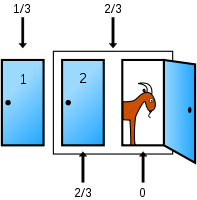Thank you for the detailed explanation. But its still wrong. :P (I know, I know, it's widely accepted but I am still arguing. sorry >.<)
Spoiler
Show

[/url]
The choice is between door number 1 and door number 2. was it unlikely that you picked right initially? yes. does that change the probability that you are choosing between 2 equally possible choices now? no. Each choice is independent.
Its like the difference between what your chances are to roll nat 20 twice in a row, vs your chance on either or 2 rolls. Your chance to roll 20 is always 5%, no matter how many 20s were rolled before that, but the aggregate probability that the overall occurrence could happen is much lower.
In the Hall problem, you have already made the first choice, in which you either conformed to probability (picked wrong door) or did not (picked right door.) that part is done, and now you have a new choice, with a 50 50 chance. The second door is not 2/3, because 3 is no longer really a choice, only 1 and 2 are.
Sorry if I appear belligerent, but I just cant see the logic in the proposed probabilities.


 Re: DM's who want you to Roleplay but can only say "No."
Re: DM's who want you to Roleplay but can only say "No."


 [/url]
[/url]
 Reply With Quote
Reply With Quote